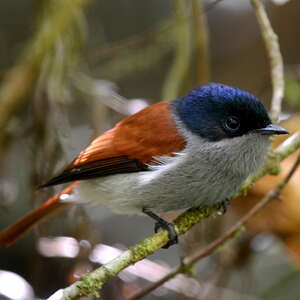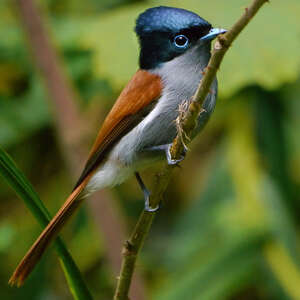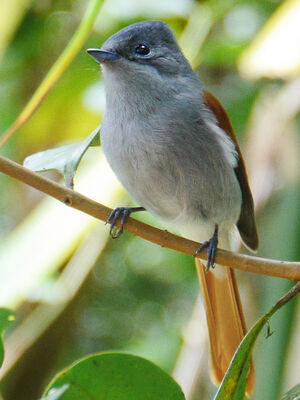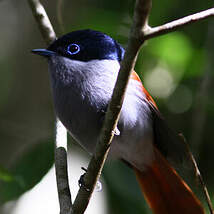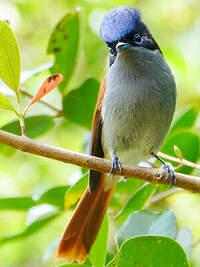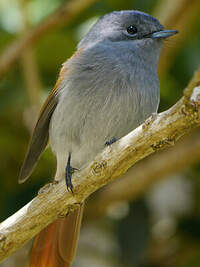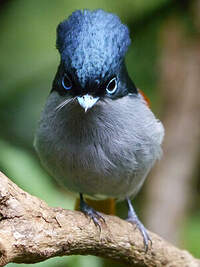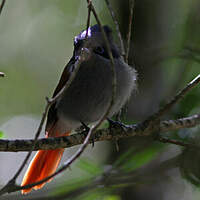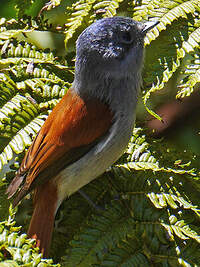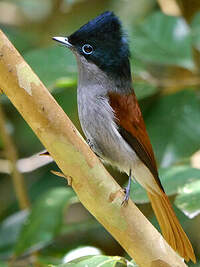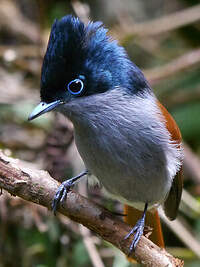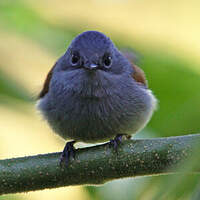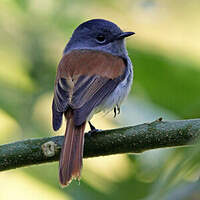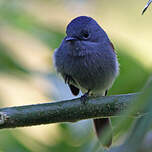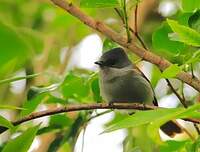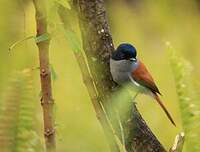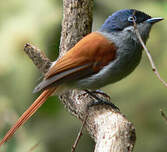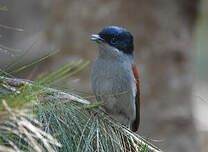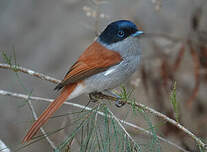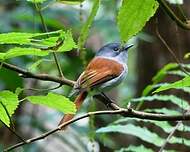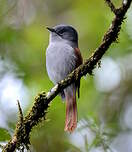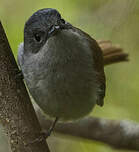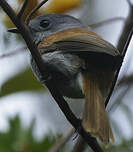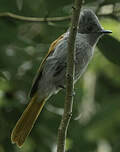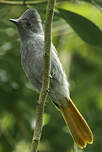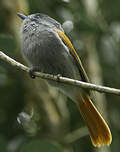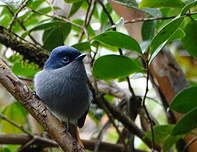Mascarene Paradise Flycatcher
Terpsiphone bourbonnensis - Tchitrec des Mascareignes
Identification
The Mascarene Paradise Flycatcher is a beautiful forest bird whose plumage combines red on the upper side and light grey on the underside. The male alone sports a dark blue hood, with a light blue eye-ring contrasting with a black iris. The tail is long and rounded at the tip. The beak and the legs are steel blue. The female is duller than the male but has the same range of colors. The cap, earcoverts and the nape are ash-gray. A semicircular steel blue orbital is visible on the lower part of the eye. The chin, throat, chest, stomach and flanks are light grey. The lower abdomen is almost white. The wings are a bright russet with a brown edging on the border of tertiary and secondary remiges. The primaries are almost entirely brown. The tail is as red as the wings. Beak and legs are the same color as the male, steel blue. The juvenile looks like the female. As with many flycatchers, males and females have whiskers around the beak.
Subspecific information 2 subspecies
- Terpsiphone bourbonnensis bourbonnensis (La Réunion)
- Terpsiphone bourbonnensis desolata (Mauritius)
Foreign names
- Tchitrec des Mascareignes,
- Monarca de las Mascareñas,
- papa-moscas-do-paraíso-das-mascarenhas,
- Maskarenenparadiesschnäpper,
- mauritiusi paradicsom-légyvadász,
- Maskarenenparadijsmonarch,
- Pigliamosche del paradiso delle Mascarene,
- maskarenparadismonark,
- Maskareneparadismonark,
- vípkar maskarénsky,
- lejskovec maskarénský,
- Mascarenerparadismonark,
- maskareenienparatiisimonarkki,
- monarca del paradís de les Mascarenyes,
- muchodławka maskareńska,
- Маскаренская райская мухоловка,
- マスカリンサンコウチョウ,
- 毛里求斯寿带,
- 馬斯卡拉林綬帶,
Voice song and cries
Habitat
Behaviour character trait
As with many other small forest insectivores, the Mascarene Paradise Flycatcher is very active and can always be noticed with its contact call.
Because of the vegetation's thickness, it takes a while for the walker to spot the bird, but it leaves a remarkable impression as it is quite unafraid and curious, and it gets surprisingly close to humans. Furthermore, this species is fiercely territorial. During the breeding season, it can become very aggressive towards other birds. It usually lives in pairs, more rarely in families. The Mascarene Paradise Flycatcher feeds in the lower layer of the canopy.Flight
Dietfeeding habits
The feeding habits of the Mascarene Paradise Flycatcher are comparable to those of the flycatchers: strictly insectivore, it captures its prey in flight with its wide beak lined with bristles, after a brief acrobatic pursuit. Its prey are mainly mosquitoes, butterflies, dragonflies, spiders, beetles and orthopterans.
Reproduction nesting
In the southern hemisphere spring (September), the couple builds the nest in the form of a conical cup at the low fork of a tree.
On Mauritius, they use Chinese Guavas and Cassias. On Réunion, they prefer Phyllanthus. The nest made of fine twigs is decorated with green moss and lichen.The male parades by standing upright like an I, beak to the sky and opened and spread tail, then by tilting the head to the side.
The female lays 2 to 3 pinkish white spotted brown eggs, rarely more. Incubation lasts 15 to 16 days and is looked after by both sexes.
The two or three nestlings are fed in the nest for fifteen days until their flight, then remain dependent on their parents until the end of the breeding season, until December.
Geographic range
Threats - protection
IUCN conservation status
concern
in the Wild
threatened
evaluated
Known as Virgin Birds on Réunion Island, this species, protected by the ministerial decree of February 17th, 1989, remains relatively abundant on this island despite deforestation (estimate of about fifty thousand individuals). Hunting, capturing or selling are completely forbidden and are considered as a crime punishable by a prison sentence and a heavy fine. On the other hand, the subspecies of Mauritius only counts two or three hundred pairs despite its protection and very few studies have been carried out on this island.
The 1990s studies showed a slight decline of the species which must be monitored.
Sources of information
- IOC World Bird List (v14.1), Gill, F and D Donsker (Eds). 2024-04-18.
- Encyclopédie des oiseaux de France (fiches), Collectif - Rédaction NICOLLE Serge
- The Birds of Africa Vol VIII : The Malagasy Region, Safford R. et Hawkins F.
- Oiseaux des iles de l'océan Indien, Langrand Olivier, ian Sinclair
- BirdLife International, BirdLife International
- Société d'Etudes Ornithologiques de la Réunion ,
Other sources of interest
 Specification sheet created on
03/08/2023 by Renan Levaillant with help of Nathalie Santa Maria
Specification sheet created on
03/08/2023 by Renan Levaillant with help of Nathalie Santa MariaTranslation by AI Oiseaux.net
published: 16-08-2013 - Updated: 03-11-2015
© 1996-2024 Oiseaux.net
- Accipitriformes
- Aegotheliformes
- Anseriformes
- Apodiformes
- Apterygiformes
- Bucerotiformes
- Caprimulgiformes
- Cariamiformes
- Casuariiformes
- Charadriiformes
- Ciconiiformes
- Coliiformes
- Columbiformes
- Coraciiformes
- Cuculiformes
- Eurypygiformes
- Falconiformes
- Galliformes
- Gaviiformes
- Gruiformes
- Leptosomiformes
- Mesitornithiformes
- Musophagiformes
- Nyctibiiformes
- Opisthocomiformes
- Otidiformes
- Passeriformes
- Pelecaniformes
- Phaethontiformes
- Phoenicopteriformes
- Piciformes
- Podargiformes
- Podicipediformes
- Procellariiformes
- Psittaciformes
- Pterocliformes
- Rheiformes
- Sphenisciformes
- Steatornithiformes
- Strigiformes
- Struthioniformes
- Suliformes
- Tinamiformes
- Trogoniformes

